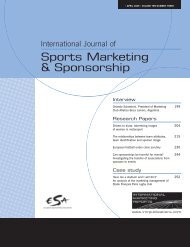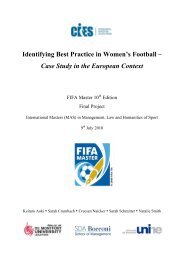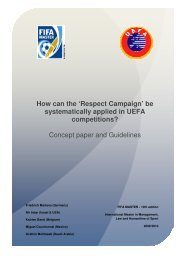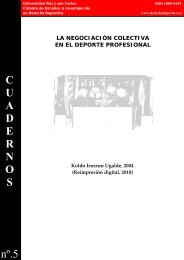Sports Marketing & Sponsorship - FIFA/CIES International University ...
Sports Marketing & Sponsorship - FIFA/CIES International University ...
Sports Marketing & Sponsorship - FIFA/CIES International University ...
- No tags were found...
You also want an ePaper? Increase the reach of your titles
YUMPU automatically turns print PDFs into web optimized ePapers that Google loves.
Sustaining the raceRESEARCH PAPERlikely to continue to do so in the long term. Theyargue that sport has become green for two reasons:first, because “governments and other corporateindustries have recognised the marketing andeducation potential of ‘green sport’” and second,because “it is an industry that has contributed toenvironmental damage in the past, and is thereforebeing called to ransom by the community at large”(p.138). There are several examples of a trendtowards ‘greener’ sport, notably the <strong>International</strong>Olympic Committee’s (IOC) decision to:• establish a Sport and Environment Commission in1996 to offer policy advice pertaining to“environmental protection” and “sustainabledevelopment” in relation to staging Olympic games(IOC, 2007);• adopt the environment as the “third dimension ofOlympism” (Smith & Westerbeek, 2004, p.135);• include in the IOC charter a requirement for allOlympic games to “demonstrate a responsibleconcern for environmental issues” (United NationsEnvironment Programme, 2007c).Other examples include:• The 2006 Global Forum for Sport andEnvironment held in Lausanne, Switzerland, whichbrought together sports and environmentalstakeholders to review “sport’s impact on andcontribution to the environment” (United NationsEnvironment Programme, 2007d);• The Melbourne 2006 Commonwealth Games,which aimed to use minimal water resources,generate minimal waste and be provided on acarbon neutral basis (Department of VictorianCommunities, 2006);• The use of fuel derived only from renewablesources for Earthrace, a powerboat capable ofcircumnavigating the Earth (Schmidt, 2006);• The non-profit Australian organisation Sport 4 theEnvironment (S4E), that aims to encourage “allsporting organisations to develop and implementenvironmental change” (2008).Smith and Westerbeek (2004, p.139) argue that sportwill become increasingly dependent on sustainablepractices: “It is absolutely clear that the sporting sectorwill experience increasing pressure to ‘clean up’ suchenvironmental blemishes. The viability of clubs,associations and events will depend on the support ofa public which will demand change, or seek sportexperienceselsewhere.” The authors make it clear thatsport, like other sectors of society, is not immune frompressures to become sustainable.The role of consumption in sportSmith and Westerbeek (2004) highlight the role thatsport plays in the phenomenon of materialconsumption (pp.139-140). ‘Natural capital’ such asland, water and energy are needed for the productionof sporting goods. Dingle (2007, pp.4-5) highlightsthe dependence of sport through sporting equipmentthat incorporates plastics and rubber – materials thatare principally manufactured from the carbon-intensiveresources of crude oil and natural gas (AmericanPlastics Council, 2004). Natural capital is alsorequired for the transportation, facility construction andspectator and athlete accommodation associated withsports events. Byproducts of these consumption-basedsports processes include a variety of waste materialsas well as air and water pollution.Jackson and Michaelis (2003, p.7) argue that suchpatterns of material consumption are reflective ofbroader patterns of consumer behaviour that aretypical of industrialised societies. They note the deeplyembedded and multi-factorial nature of modernconsumerism: “We appear to be locked into currentconsumption trends by a combination of past choices,technology, economic incentives, institutions, our ownpsychology and the culture and social systems weinhabit (p.7).”Jackson and Michaelis (pp.10-11) conclude thatcurrent patterns of global material consumption areunsustainable, however; they suggest that sustainableconsumption is possible with a ‘change management’approach from governments in conjunction withappropriate ‘non-governmental initiatives’.88<strong>International</strong> Journal of <strong>Sports</strong> <strong>Marketing</strong> & <strong>Sponsorship</strong> ● OCTOBER 2009 ●
















